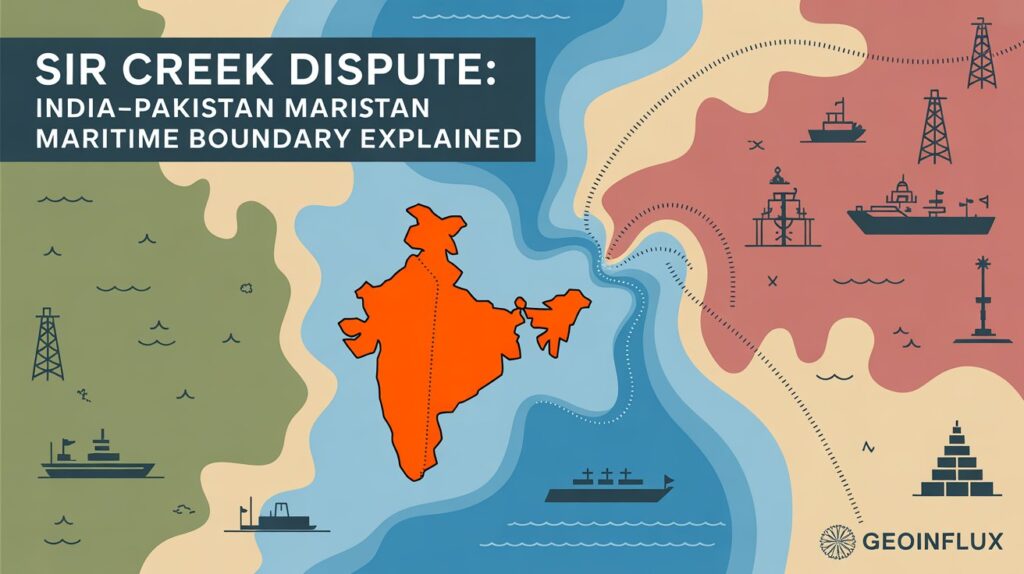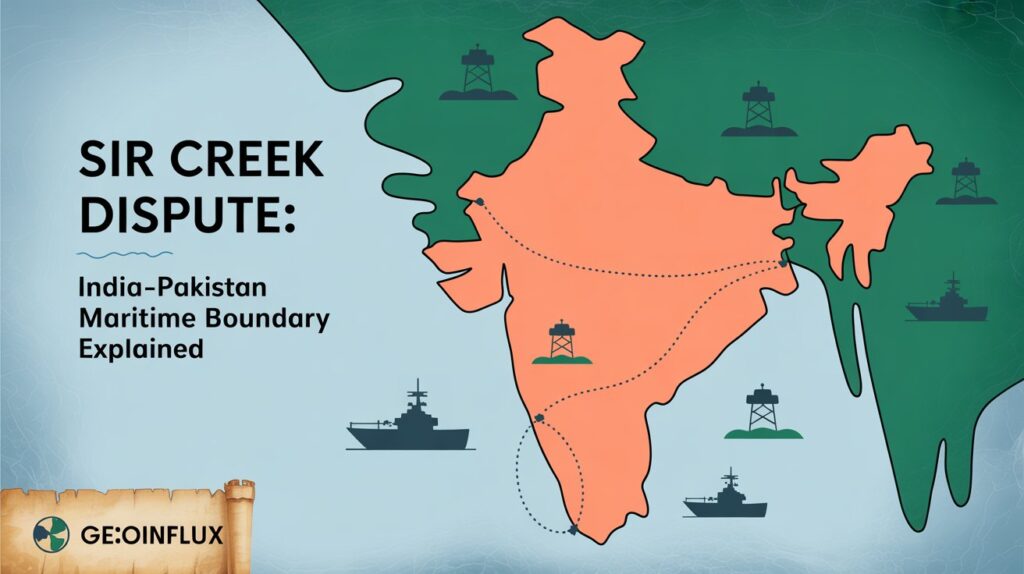India’s Defence Minister Rajnath Singh’s Sir Creek Dispute warning has reignited the India-Pakistan maritime dispute. Explore the military, legal, economic, and human dimensions shaping this high-stakes flashpoint.
What is the Sir Creek Dispute and Why Does Rajnath Singh’s Warning Matter?
The Sir Creek dispute is a long-standing boundary conflict between India and Pakistan, but Defence Minister Rajnath Singh’s October 2025 warning transformed it into a high-stakes geopolitical flashpoint.
Singh’s statement that “one route to Karachi passes through Sir Creek” reframed the estuary from a marshland border to a strategic naval access point, threatening Pakistan’s economic lifeline.

This blog unpacks the dispute across military, legal, economic, and humanitarian dimensions to explain why the Sir Creek crisis is more than just a border skirmish.
For deeper context, see our India-Pakistan Relations coverage.
Why Did Rajnath Singh Issue a Sir Creek Warning Against Pakistan?
Singh’s warning was a direct response to Pakistan’s military infrastructure buildup near Sir Creek, including forward bases, radar sites, and bunkers. These preparations suggested hybrid warfare tactics such as drones, speedboats, and fog-assisted incursions.
India countered by reinforcing the Border Security Force (BSF) with hovercrafts, while also deploying Navy patrol aircraft (P-8Is), Army fortifications, and Air Force BrahMos batteries.
The warning served two purposes:
- To signal deterrence by connecting Sir Creek to Karachi’s vulnerability.
- To frame Pakistan’s expansion as aggression, making India’s defensive buildup more legitimate in international perception.
What is the Strategic Implication of Rajnath Singh’s ‘Route to Karachi’ Warning?
Singh’s statement reframed Sir Creek as a direct naval corridor to Karachi, Pakistan’s economic hub. This message linked a local territorial issue to the security of Pakistan’s trade arteries, raising deterrence stakes.
Historically, India has signaled similar strength, such as in the 1965 war when Indian forces advanced to Lahore. By combining historical precedent with modern operational capability, Singh presented India as ready for maximum retaliation if provoked.
How Does the Sir Creek Warning Connect to ‘Operation Sindoor’?
Singh tied the warning to Operation Sindoor, a retaliatory campaign launched after the Pahalgam terror attack. Operation Sindoor demonstrated India’s ability to:
- Neutralize Pakistan’s air defense.
- Conduct precision retaliatory strikes.
- Expose vulnerabilities across the entire western front, from Leh to Sir Creek.
By citing it, Singh reinforced the credibility of his deterrence message, India has recent proof of operational effectiveness against hybrid warfare tactics.
What are the Conflicting Historical and Legal Claims Over Sir Creek?
The dispute stems from different interpretations of the 96-km tidal estuary boundary between Gujarat (India) and Sindh (Pakistan).
- India’s Claim (Thalweg Principle): Boundary follows the mid-channel, as Sir Creek is navigable at high tide.
- Pakistan’s Claim (1914 Bombay Resolution): Boundary lies along the eastern bank, placing the creek inside Sindh.
Sir Creek Dispute Claims – Comparison Table
| Parameter | India’s Stance | Pakistan’s Stance | Strategic Implication |
|---|---|---|---|
| Boundary Principle | Thalweg (mid-channel) | Eastern bank | Defines maritime control |
| Basis of Claim | Navigability + intl. law | 1914 Bombay Resolution | Legitimacy of claim |
| Economic Stakes | EEZ access + fishing | Resource extension | Control of offshore oil/gas |
The 1968 India-Pakistan Tribunal resolved other Kutch disputes but left Sir Creek unsettled, leaving this issue as a persistent irritant.
Why is Sir Creek Crucial for India and Pakistan’s Exclusive Economic Zones (EEZ)?
Resolving the Sir Creek boundary determines each country’s EEZ and continental shelf in the Arabian Sea. The stakes are high:
- Offshore oil and gas reserves are at play.
- The area has rich fishing grounds, vital for coastal economies.
- UNCLOS (Law of the Sea) requires clarity for EEZ claims; delays could allow the International Seabed Authority (ISBA) to claim disputed areas.
India could pursue partial delimitation to secure some claims, but a full settlement benefits both sides.
How is the Sir Creek Dispute Connected to the Indus Waters Treaty?
The conflict also intersects with water-sharing politics. Pakistan’s Left Bank Outfall Drain (LBOD) allegedly violates Article IV of the Indus Waters Treaty, as it floods Indian territory during low tide.
If proven, India could push for international arbitration under IWT, giving New Delhi strategic leverage beyond military deterrence. This entanglement makes Sir Creek not just a land and sea issue, but also a resource management crisis.
How Does the Sir Creek Conflict Affect Local Fishermen and Human Security?
Beyond military and legal dimensions, Sir Creek is a humanitarian problem.
- Fishermen from both Gujarat and Sindh are often arrested for crossing the unsettled boundary.
- Fishing boats are seized or destroyed, impacting livelihoods.
- Development projects ignore these communities, displacing boat-building and allied industries.
The result is a permanent low-intensity crisis for border populations, who become collateral in the geopolitical standoff.
What are the Risks of Prolonged Military Buildup in the Sir Creek Estuary?
The continued military expansion raises risks of:
- Miscalculation during patrols in foggy terrain.
- Escalation into larger conflict, as seen in the 1999 Atlantique incident.
- Economic disruption, since Karachi is within reach of India’s naval forces.
India’s doctrine now explicitly ties Sir Creek deterrence to economic warfare potential, meaning any clash could spiral rapidly.
Can the Sir Creek Dispute Be Resolved, or is it Intractable?
The dispute is complex but not unsolvable. The key barriers are historical mistrust and linkage politics — Pakistan ties Sir Creek to broader Kashmir talks, while India prefers treating it separately.
Options for resolution include:
- International arbitration under UNCLOS.
- Bilateral maritime delimitation using equidistance method.
- Confidence-Building Measures (CBMs) for fishermen until full settlement.
If resolved, Sir Creek could become a catalyst for wider Indo-Pak dialogue, rather than a trigger for escalation.
GeoInflux Prognosis: What Lies Ahead for Sir Creek?
- India’s Position: Aggressive deterrence, leveraging both Karachi’s vulnerability and Operation Sindoor’s success.
- Pakistan’s Position: Infrastructure expansion, signaling hybrid war readiness.
- Future Pressure Points: EEZ delimitation, Indus Waters Treaty disputes, and humanitarian fallout.
GeoInflux assesses that Sir Creek is structurally resolvable, but entrenched mistrust makes short-term progress unlikely. The dispute will remain a flashpoint requiring close monitoring.
FAQs on the Sir Creek Dispute
1. Why has the Sir Creek dispute remained unresolved since 1968?
The 1968 Tribunal deliberately left Sir Creek unsettled. Both countries hardened positions since then, tying it to broader disputes like Kashmir. The absence of trust and repeated military crises prevent progress.
2. How does Sir Creek impact India and Pakistan’s maritime boundaries?
Sir Creek determines EEZ access, which defines control over fishing, offshore oil, and gas reserves. Without settlement, both countries risk losing resource claims under UNCLOS rules.
3. What role does the Indus Waters Treaty play in the Sir Creek conflict?
Pakistan’s LBOD project may violate Article IV by flooding Indian areas. This gives India a potential arbitration tool, making water-sharing politics central to Sir Creek.
4. How are local fishermen impacted by the Sir Creek dispute?
Hundreds are arrested each year for crossing undefined maritime lines. Their boats are confiscated, and their livelihoods disrupted, turning a geopolitical conflict into a human tragedy.
5. Could international arbitration resolve the Sir Creek dispute?
Yes. Arbitration under UNCLOS could finalize EEZ boundaries. However, Pakistan fears losing leverage, while India worries about setting a precedent for third-party involvement.
Related Articles: What Other Disputes Link to Sir Creek?
🔎 References: What are the sources on the Sir Creek Dispute?
- Ministry of External Affairs, Government of India – Official Statements on India–Pakistan Boundary Issues
👉 https://mea.gov.in - United Nations Convention on the Law of the Sea (UNCLOS) – Maritime Boundary Framework
👉 https://www.un.org/depts/los - Pakistan Ministry of Foreign Affairs – Position on Sir Creek Dispute
👉 https://mofa.gov.pk - Institute of Peace and Conflict Studies (IPCS) – The Sir Creek Dispute: An Overview
👉 https://www.ipcs.org - The Hindu – Explained: The Sir Creek Dispute and Its Strategic Significance
👉 https://www.thehindu.com - ORF (Observer Research Foundation) – Maritime Boundaries and the Sir Creek Issue
👉 https://www.orfonline.org - South Asian Voices – Sir Creek and India-Pakistan Maritime Tensions
👉 https://southasianvoices.org - Carnegie Endowment for International Peace – India–Pakistan Border Conflicts
👉 https://carnegieendowment.org - BBC News – India–Pakistan Disputes: Sir Creek Explained
👉 https://www.bbc.com/news - Journal of Borderlands Studies – Sir Creek and International Boundary Arbitration





